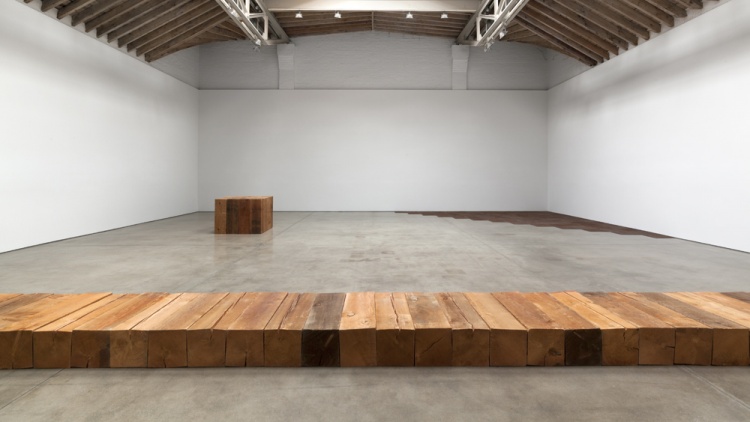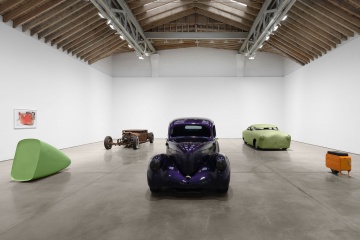Paula Cooper Gallery
529 West 21st Street
New York, NY 10011
212 255 1105
Also at:
534 West 21st Street
New York, NY 10011
212 255 1105
521 West 21st Street
New York, NY 10011
212 255 1105
New York, NY 10011
212 255 1105
Also at:
534 West 21st Street
New York, NY 10011
212 255 1105
521 West 21st Street
New York, NY 10011
212 255 1105
Paula Cooper Gallery, the first art gallery in SoHo, opened in 1968 with an exhibition to benefit the Student Mobilization Committee to End the War in Vietnam. The show included works by Carl Andre, Dan Flavin, Donald Judd, Robert Mangold and Robert Ryman, among others, as well as Sol LeWitt’s first wall drawing. For fifty years, the gallery’s artistic agenda has remained focused on, though not limited to, conceptual and minimal art.
In 1996, the gallery moved to Chelsea to occupy an award-winning redesigned 19th century building. The architect was Richard Gluckman. In 1999, Paula Cooper opened a second exhibition space on 21st Street. In 2020, the Gallery was pleased to open a new, seasonal location in Palm Beach, Florida.
Beyond its immediate artistic program, the gallery has regularly hosted concerts, music symposia, dance performances, book receptions, poetry readings, as well as art exhibitions and special events to benefit various national and community organizations. For 25 years until 2000, the gallery presented a much celebrated series of New Year’s Eve readings of Gertrude Stein’s The Making of Americans and James Joyce’s Finnegans Wake.
Artists Represented:
Carl Andre
Estate of Terry Adkins
Tauba Auerbach
Estate of Jennifer Bartlett
Estate of Bernd and Hilla Becher
Céleste Boursier-Mougenot
Cecily Brown
Sophie Calle
Beatrice Caracciolo
Estate of Sarah Charlesworth
Estate of Bruce Conner
Estate of Jay DeFeo
Mark di Suvero
Sam Durant
Estate Luciano Fabro
Matias Faldbakken
Ja'Tovia Gary
Liz Glynn
Robert Grosvenor
Hans Haacke
Estate of Douglas Huebler
Michael Hurson
Julian Lethbridge
Estate of Sol LeWitt
Eric N. Mack
Christian Marclay
Justin Matherly
Peter Moore
David Novros
Estate of Claes Oldenburg & Coosje van Bruggen
Paul Pfeiffer
Walid Raad
Veronica Ryan
Joel Shapiro
Rudolf Stingel
Kelley Walker
Dan Walsh
Meg Webster
Robert Wilson
Jackie Winsor
Bing Wright
Carey Young
Works Available By:
Jonathan Borofsky
Dan Flavin
Donald Judd
Sherrie Levine
Jan Schoonhoven
Atsuko Tanaka
Alan Shields

Exhibition view of Carl Andre, at Paula Cooper Gallery, New York, 2014. © Carl Andre / VAGA 2014. Courtesy Paula Cooper Gallery, New York.
Sarah Charlesworth
Sarah Charlesworth: Seduction and Desire
February 20, 2025 - April 12, 2025
Sarah Charlesworth (1947–2013) is known for her conceptually driven and visually alluring photo-based works that subvert and deconstruct cultural imagery. Entitled Desire and Seduction, the current exhibition will examine how these themes emerged and recurred within Charlesworth’s work from the early 1980s through the mid-2000s. Populated with fetish objects and silken fabrics, isolated body parts and masked strangers, the exhibition invites the viewer to locate their own desire.
Beginning with her celebrated Objects of Desire series (1983–88), Charlesworth sought to make visible the “shape of desire.”[1] Meticulously excising images from a range of sources—including fashion magazines, pornography, and archeological textbooks—she then re-photographed the cutouts against fields of pure color. In each work, Charlesworth has paired the image with a signifying color: red (sexual passion), black (dominance or death), green (natural growth), yellow (material value), blue (spiritual or metaphorical desire). The prints are enclosed within coordinated lacquered wood frames and either stand alone or are combined in diptychs and triptychs.
The earliest works in the exhibition address sexuality through gender stereotypes, such as the toned male torso outlined in clinging wet fabric in White T-Shirt (1983), a sweep of voluminous locks in Blonde (1983–84) and the anonymous wedding dress in Bride (1983–84). Charlesworth disrupts the viewer’s expectations in Red Mask (1983) with an image of an onnagata Kabuki actor playing the role of a geisha. In the two-part work Figures (1983), a silk evening gown is juxtaposed with a satin bondage suit on black and red backgrounds, intertwining dominance, power and passion.
Both the finesse of Charlesworth’s seductive Cibachrome prints and her fascination with the iconography of desire were expanded in subsequent series, which often employed familiar motifs. Maintaining a focus on isolated images in saturated fields of color, from 1992 onwards Charlesworth’s photographs were composed and produced in her studio using the camera as a tool to conjure fantasies of her own imagination. For example, the cut-out image of an elusive Red Scarf from 1983 reappeared wrapped around a pair of heads in Red Veils (1992–93), and a thick red curtain is parted to make room for a telescope’s shaft in Untitled (Voyeur) (1995). In Pleasure of the Text (1992–93) Charlesworth invokes the use of silk in magic tricks by concealing an open book beneath a luxurious white scarf and suspending the composition against a black background. Presenting mysterious scenes imbued with unresolved intrigue, these works incite desire for the impossible.
Sarah Charlesworth (1947-2013) has been the subject of one-person exhibitions at a number of institutions including the major survey, “Sarah Charlesworth: Doubleworld,” at the New Museum, New York (2015), which traveled to the Los Angeles County Museum of Art (2017); and a retrospective organized by SITE Santa Fe (1997), which traveled to the Museum of Contemporary Art, San Diego (1998), the National Museum of Women in the Arts, Washington, DC (1998), and the Cleveland Center for Contemporary Art (1999). Her work is in important public collections such as the Museum of Modern Art and the Metropolitan Museum of Art, New York; the Walker Art Center, Minneapolis; the Centre Pompidou, Paris; the Stedelijk Van Abbemuseum, Eindhoven; and the Victoria and Albert Museum, London. Charlesworth taught photography for many years at the School of Visual Arts, New York; the Rhode Island School of Design; and Princeton University.
[1] Sarah Charlesworth interviewed by Susan Fisher Sterling, March 23, 1997, in Sarah Charlesworth, SITE Santa Fe, 1997, p. 80
Robert Grosvenor
February 15, 2025 - March 22, 2025
An exhibition of recent sculpture and photography by Robert Grosvenor will survey his prolonged fascination with the aerodynamics of machinery. Since the 1980s, Grosvenor has applied his subtly elusive formal vocabulary to the vernacular of American car culture by transforming obsolete vehicles into inoperable sculptures. A series of exhibitions of uncannily altered vehicles isolated in striking or purpose-built spaces have frequently enshrined these works. Here, numerous sculptures are gathered under one roof in a lively installation that enhances their individual narrative qualities.
In the main room, a reflective deep purple sculpture is flanked with a vibrant green form on one side and a heavily rusted object on the other. Each work is a found object, perfected through small adjustments that enhance its existing form. The purple sculpture (Untitled, 2023) has no windshield and its headlights have been sprayed matte black, but it otherwise looks like it could be spurred into action. The green sculpture (Untitled, 2022) is smooth and pure, rocket-like, inanimately still. The rusted work (Untitled, 2022) was already romantically sculptural, the wooden planks of the truck bed aging like driftwood and its patina warm with wear. The machine still bears the name of its maker on its back, but the roof has been lowered to remove it completely from the realm of functionality. Arranged in a triangular formation facing the street with other smaller works surrounding them, the vehicles recall the gallery’s previous incarnation as a parking garage.
The front gallery contains a nautical sculpture (Untitled, 2023) stripped of its operative apparatus and leaning to one side. Painted in white and vibrant turquoise to accentuate its curves and points, the work is both familiar and ambiguous, imparting a distinct strangeness. On the surrounding walls are photographs of unlikely objects pictured against blue skies and green lagoons, complementing the sculpture in theme and tone. Some images depict vehicles and structures so characteristic of Grosvenor that one wonders if he made them himself. Animated with humor and vivid color, the photographs depict a compelling alternate reality.

 Back to all Member Galleries
Back to all Member Galleries




